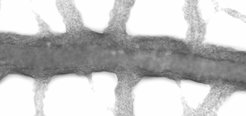Stripes, dots, and waves
Researchers from the Max Planck Institute for Dynamics und Self-Organization push Turing patterns to new limits
Nature fascinates us with its striking patterns, stripes or dots on animal coats or seashells. How these patterns are formed has been a subject of research for many decades, since the pioneering work of Alan Turing, a well-known British mathematician from the last century. In the recent issue of Proceedings of the National Academy of Science (PNAS), Jean-Daniel Julien and Karen Alim, from the "Biological Physics and Morphogenesis" research group at the Max Planck Institute for Dynamics and Self-organization (MPIDS), show how flows coupled to pattern formation can overcome the usual limits of pattern size. Here, it is sufficient for one of the messengers of the pattern-forming mechanism to be carried along with the flow. This coupling therefore makes it possible to exceed the limit in pattern size, usually constrained by physical parameters. In the future, this newly discovered role of fluid flows could be used to transport fluids or rigid objects over long distances in smart materials, such as active hydrogels.

Flows over remarkably long distances are crucial for the functioning of many organisms, in all kingdoms of life. They are essential to generate deformations, necessary for migration or development, or to distribute resources and signals. One of the main mechanisms to power such flows is the propagation of wave-like patterns of contracted and stretched regions. The longer the wavelength of the pattern, the stronger the flows. However, as Alan Turing already noticed, pattern size is limited by physical parameters. Can we overcome this constraint by coupling the flows to the pattern of contraction and subsequent stretching?
An interplay between flow and patterning
The researchers used a mathematical model to investigate the possible effects of flows on patterns. A signaling molecule activates the wave patterns, but is also transported by the flow it generates. The transport facilitates the propagation of the molecule, which in turn improves the organization and pushes the limit of the size of the waves by almost an order of magnitude. This simple mechanism explains the emergence of long-range patterns outcompeting the physical limits.
"Our work shows the importance of active flows in biophysical models for pattern formation, not only as regulating input or emerging output, but rather as a complete part of a self-organized machinery," says Dr. Jean-Daniel Julien. "Contractions and fluid flows are observed in all types of organisms, so our new concept is likely to be relevant for a broad class of systems, especially during the development of organisms where signaling molecules have to travel large distances in short time," emphasizes Dr. Karen Alim, head of the Biological Physics and Morphogenesis research group at MPIDS.
